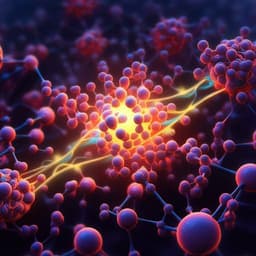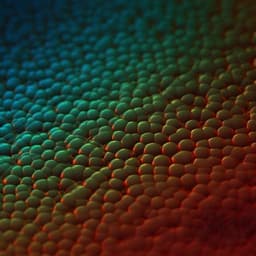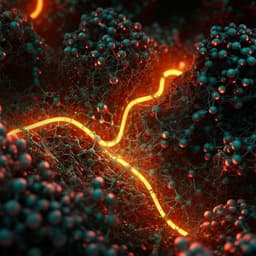
Engineering and Technology
Boosting the interfacial superionic conduction of halide solid electrolytes for all-solid-state batteries
H. Kwak, J. Kim, et al.
Discover the groundbreaking research by Hiram Kwak, Jae-Seung Kim, and their team on halide nanocomposite solid electrolytes, paving the way for next-generation all-solid-state batteries. Their innovative synthesis method enhances ionic conductivities and compatibility for improved battery performance, showing remarkable stability with sulfide solid electrolytes.
~3 min • Beginner • English
Introduction
The study addresses the need for solid electrolytes (SEs) that combine high ionic conductivity, electrochemical stability, manufacturability, and cost-effectiveness for all-solid-state batteries (ASSBs). Sulfide SEs exhibit high ionic conductivity and deformability but have low oxidative stability, limiting compatibility with high-voltage layered cathodes. Oxide SEs have better oxidation stability but are brittle and require high-temperature processing. Recently, halide SEs have emerged as promising due to balanced mechanical and electrochemical properties, with conductivities up to a few mS cm−1. Conventional approaches (aliovalent substitution, defect engineering) improved conductivity but often rely on scarce elements (Y, Sc, In) and face compatibility issues, particularly with sulfide SE layers in practical cell architectures. Moreover, while interfacial conduction enhancements have been observed historically in heterostructures (e.g., LiI/Al2O3), a clear design principle for achieving superionic conduction at interfaces in practical, highly conductive SEs has been lacking. This work proposes and tests halide nanocomposite SEs (HNSEs) that leverage interfacial superionic conduction via controlled interphase formation to boost ionic transport and compatibility, using cost-effective Zr-based chlorides and oxides for Li+ and Na+ conduction.
Literature Review
Prior work established sulfide SEs (e.g., argyrodites Li6PS5ClyBry) with conductivities of 1–10 mS cm−1 at room temperature and good processability, but they suffer from low oxidative stability (~2.6 V vs Li/Li+), causing issues with uncoated Ni-rich layered oxides. Oxide SEs (e.g., LLZO) offer better oxidative stability but are brittle and challenging to process without sintering or liquids. Halide SEs (e.g., Li3YCl6, Li2InCl5, Li3ScCl6, Li2Sc2/3Cl4, Li2ZrCl6, Li3YbCl6) have shown moderate-to-high conductivities (0.19–3 mS cm−1) and better electrochemical stability. Enhancements in halides have been achieved through aliovalent substitution (e.g., Li3−xM1−xZrCl6 with M = Y, Er, In, Sc; Li2+xZr1−xMxCl6 with M = Fe, Cr, V) and structural disorder (site disorder, stacking faults) dependent on synthesis. Na halide analogues improved via similar strategies but remained ≤0.066 mS cm−1 near room temperature. The electrochemical stability is influenced by central metal cations and halide anions; F-substitution can raise oxidation stability but often reduces ionic conductivity. Halide SEs also have poor cathodic stability vs Li metal anodes. Practical ASSB designs often combine halide catholytes with sulfide SE layers, but compatibility at halide/sulfide interfaces has been underexplored and problematic. Historically, interfacial ionic conductivity enhancements in heterostructures (e.g., LiI/Al2O3, CaF2/BaF2, LiF/silica, LiBH4/Al2O3, polymer/inorganic fillers) were attributed to space-charge effects, yet a generalizable, mechanistic design principle for superionic interfacial conduction in mS cm−1-class SEs remained unclear.
Methodology
Materials synthesis: HNSEs were prepared mechanochemically by ball milling stoichiometric mixtures of Li2O (or Na2O), LiCl (or NaCl), and ZrCl4 in ZrO2 vials with ZrO2 balls at 600 rpm for 20 h under Ar, forming ZrO2 nanoparticles and Li2ZrCl6 (or Na2ZrCl6). Compositions included binary ZrO2-2Li2ZrCl6 and ternaries ZrO2–ACl–A2ZrCl6 (A = Li, Na). Fluorinated HNSEs (ZrO2-2Li2ZrCl5F) were synthesized by milling Li2O, ZrF4, and ZrCl4 (2:0.5:2.5). Control nanomixtures were made by milling commercial oxide nanoparticles (e.g., ~20 nm ZrO2) with Li2ZrCl6.
Characterization: Synchrotron X-ray diffraction (XRD) and pair distribution function (PDF) analyses probed phases and local structure; Zr K-edge XANES/EXAFS and Cl K-edge XANES assessed coordination and bonding; cryogenic HRTEM visualized nanostructure and interfaces; 7Li MAS-NMR examined local Li environments and interphase signatures, including exchange experiments in 7Li|LPSCl|HNSE|LPSCl|7Li symmetric cells.
Electrochemistry: Ionic conductivities were measured by AC impedance on Ti|SE|Ti symmetric cells at 30 °C (frequency 10 mHz–7 MHz; amplitude 10 mV). Pellets (~6 mm diameter, ~500 μm thick) were cold-pressed (370 MPa). Arrhenius behavior and activation energies were extracted. ASSB cells employed Li-In counter/reference electrodes, LCO or single-crystal NCM88 cathodes, and sulfide SE Li9PS5Cl (LPSCl) as monolayer or as a bilayer with ZrO2-LZCF. Cells were assembled under high pressure (~370 MPa pressing; tested under ~70 MPa stack pressure) and evaluated at 30 or 60 °C with cutoffs up to 4.5 V vs Li/Li+. Cyclic voltammetry (0.1 mV s−1 to 5 V) assessed oxidative stability; EIS tracked interfacial impedance evolution during cycling.
Computations: DFT (VASP, PBE-GGA, PAW, 520 eV cutoff) assessed formation energetics, structural relaxations, electrochemical stability (grand potential phase diagrams), and interface reaction energies versus cathodes and sulfide SEs. Ab initio molecular dynamics (AIMD; NVT, Nose-Hoover; 200 ps runs at 550–750 K) quantified Li+ diffusivities; diffusion pathways and channel sizes were analyzed (Zeo). Interface models incorporated anion exchange (O-for-Cl) at Li2ZrCl6/ZrO2 interfaces forming oxygen-substituted Li2.5ZrCl5.5O0.5 (LZCO) interphases with local Li enrichment.
Cell testing conditions included specific currents (e.g., 16.4, 82.0, 400, 800 mA g−1), cut-off voltages (4.3–4.7 V), temperatures (30, 60 °C), and long-term cycling (up to ~2000 cycles).
Key Findings
- Mechanochemical synthesis produced nanostructured HNSEs ZrO2(-ACl)-A2ZrCl6 (A = Li, Na) with percolating ZrO2 networks and embedded Li2ZrCl6 nanograins (<10–20 nm), yielding extensive interfaces.
- Ionic conductivity enhancements at 30 °C:
• Li+: Li2ZrCl6 baseline 0.40 mS cm−1; ZrO2-2Li2ZrCl6 reached 1.1 mS cm−1 (activation energy reduced from 0.37 to 0.31 eV); optimal ternary 0.44ZrO2–1.26LiCl–0.56Li2ZrCl6 achieved 1.3 mS cm−1.
• Na+: Na2ZrCl6 baseline 0.011 mS cm−1; 0.13ZrO2–0.61NaCl–0.26Na2ZrCl6 achieved 0.11 mS cm−1 (≈10× improvement; highest among Na halide SEs reported).
- Interfacial superionic mechanism:
• DFT and EXAFS/PDF indicate interfacial O-for-Cl substitution forming Li-enriched LZCO interphases; Zr–Cl bond elongation and broadened Zr–Zr correlation reflect interfacial structural modification.
• PDF fitting (low r) requires inclusion of LZCO interphase; composition fit: ~1.47Li2ZrCl6–0.36LZCO–1.01ZrO2–0.16Li2O.
• AIMD predicts ~11× higher Li+ diffusivity in LZCO vs Li2ZrCl6 at 300 K; enhanced diffusion arises from widened channels (volume expansion, O substitution) and higher local Li content; Li probability density shows more 3D-connected pathways.
• 7Li MAS-NMR exhibits an additional interphase peak at −0.42 ppm in HNSE (absent in Li2ZrCl6); its area fraction increases after Li exchange cycling (37.0%→40.7%), corroborating active interfacial Li transport.
- Control comparisons: Physical mixtures with commercial ZrO2 (nZrO2-2Li2ZrCl6) show smaller gains (0.6 mS cm−1) than mechanochemical HNSE (1.1 mS cm−1), highlighting the importance of nanoscale interphase formation and percolating interfaces. LiCl/Li2ZrCl6 interfaces alone primarily increase Li accumulation but not channel size, yielding smaller conductivity gains.
- Generality: Other oxides (Al2O3-3Li2ZrCl6: 0.88 mS cm−1; SnO2-2Li2ZrCl6: 1.6 mS cm−1) and aliovalent substitution (Li2+xZr1−xFexCl6, max 1.4 mS cm−1) also benefit via two-step HNSE protocols.
- Fluorinated HNSEs: Although Li2ZrCl5F alone lowers conductivity (0.35 mS cm−1), ZrO2-2Li2ZrCl5F HNSE restores/enhances it (0.49 mS cm−1) and significantly improves oxidative behavior; CV integrated oxidation currents to 5.0 V: 1st cycle 1.98 mA V−1 g−1 for ZrO2-2Li2ZrCl5F vs 2.76 for Li2ZrCl6; 2nd cycle 0.55 vs 2.00. DFT indicates formation of passivating Li2ZrF6 and Li3Zr4F19 extends the practical anodic limit.
- Halide/sulfide compatibility: DFT interface reaction energies indicate poor compatibility of halides with LPSCl; experiments show electrochemically driven incompatibility at elevated temperature. Fluorinated HNSE (ZrO2-LZCF) forms a stable/passivating interface, enabling use of sulfide monolayers.
- ASSB performance:
• LCO cathodes at 60 °C to 4.3 V (monolayer LPSCl): initial Coulombic efficiencies (ICE) 94.5% (ZrO2-LZCF), 91.8% (ZrO2-LZC), 80.3% (LZC); 100-cycle capacity retention 93.7%, 68.0%, 1.7%, respectively.
• With (ZrO2-LZCF)|LPSCl bilayer and LZC catholyte, capacity retention improves from 1.7% to 70.0% at 100 cycles; ZrO2-LZCF catholyte performs well with both mono- and bilayers (~93–94% retention).
• High-voltage stability to 4.5 V at 30 °C demonstrated; good rate capability (e.g., S-NCM88 at 800 mA g−1).
• Long-life S-NCM88 cells (LPSCl monolayer, ZrO2-LZCF catholyte) at 30 °C and 400 mA g−1 deliver ~115 mAh g−1 after nearly 2000 cycles with capacity retention ~90.8% at 1000th and 82.0% at 2000th cycles (relative to 3rd cycle).
Discussion
The work demonstrates that superionic interfacial conduction can be designed in halide SE composites by inducing controlled interphase chemistry at oxide/halide boundaries. Oxygen substitution (from Li2O reacting with ZrCl4 to form ZrO2) into the halide lattice at interfaces, coupled with local Li enrichment, expands Li+ transport channels and creates more 3D-connected diffusion networks, leading to substantial conductivity gains beyond conventional space-charge layer effects. The mechanochemical route generates nanoscale percolating networks maximizing interfacial area and interphase population, which is key to the observed enhancements. Extending the strategy to other oxides and to fluorinated halides generalizes the approach: fluorination improves oxidative stability and halide/sulfide compatibility but typically reduces conductivity; embedding in an HNSE offsets this drawback, enabling high-voltage operation and stable sulfide interfaces via passivating F-rich interphases. In practical ASSB configurations, especially at elevated temperatures, halide/sulfide incompatibility can degrade performance; the fluorinated HNSE catholyte (ZrO2-LZCF) mitigates this, enabling robust cycling, high voltage (up to 4.5–4.7 V), fast charge, and very long life in Li-In cells with LCO and Ni-rich layered cathodes. The findings provide a mechanistic and practical design framework for interfacial superionic conduction applicable to broader halide/oxide combinations.
Conclusion
This study introduces halide nanocomposite solid electrolytes (HNSEs) that leverage interfacial oxygen-substituted interphases to achieve superionic conduction and improved compatibility in all-solid-state batteries. Mechanochemical synthesis creates percolating ZrO2/Li2ZrCl6 nanostructures where O-substituted, Li-enriched interphases (LZCO) widen Li+ pathways and boost conductivity (Li+: 0.40→1.1–1.3 mS cm−1; Na+: 0.011→0.11 mS cm−1 at 30 °C). 7Li NMR, synchrotron X-ray analyses, and AIMD substantiate the interfacial mechanism. The strategy generalizes to other oxides and to fluorinated chlorides, where it offsets conductivity losses and provides passivating behavior, enabling high-voltage stability and compatibility with sulfide SEs. ASSB cells using ZrO2-LZCF exhibit excellent performance, including long-term cycling (~2000 cycles) and high-rate capability. Future work could explore broader oxide/halide chemistries, optimize interphase formation and percolation architectures, extend to Li-metal anodes, access expanded compositional regions (alternative oxygen sources), and scale synthesis for practical manufacturing.
Limitations
- Interphase composition and distribution are inferred from indirect probes (PDF fitting, NMR signatures, DFT) rather than direct atomic-scale chemical mapping across interfaces; quantitative control over interphase thickness and uniformity remains to be established.
- Electrochemical demonstrations use Li-In negative electrodes; compatibility and stability against Li metal anodes were not addressed and halide SEs may exhibit cathodic instability vs Li metal.
- Long-term stability and compatibility were shown under substantial stack pressure (~70 MPa) and specific lab-scale conditions; performance under lower pressures and larger-format cells requires validation.
- Non-fluorinated Li2ZrCl6 shows incompatibility with sulfide SEs at elevated temperature; while fluorination mitigates this, trade-offs between conductivity and stability may persist depending on composition.
- The mechanochemical process parameters (e.g., milling energy, time) critically affect interphase formation; reproducibility and scale-up protocols need further development.
Related Publications
Explore these studies to deepen your understanding of the subject.







